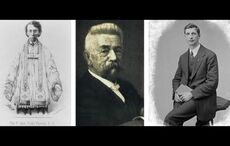As we approach land on the Staten Island ferry, coming into dock, historian Lynn Rogers asks us to imagine a line of ships, carrying hundreds of famine escapees, spread out before us.
Ships may have waited here for days as inspectors checked all passengers for signs of disease, as those who were ill grew worse and further numbers became infected.
Wading through the water to Staten Island’s shore, carrying all their worldly possessions, many Irish people ended their struggle to survive the famine by beginning a further struggle to survive New York.
As we reflected on the memory of those lost, all those gathered on the ferry on a recent Sunday afternoon received the opportunity to lay a rose in the water to commemorate those lost in the Great Hunger, those who died in Ireland and those who traveled to the US only to meet their fate on foreign shores.
“I’ve waited a long time to do that,” Lynn says.
The tossing of green, white and orange roses into the water saw an end to a day of exploration and discovery at New York’s Irish Hunger Memorial, designed by artist Brian Tolle. Following the walk and talk with artist Tolle, attendees accompanied Friends of Abandoned Cemeteries on the ferry to Staten Island to remember the Irish buried in two cemeteries there.
Between 1845 and 1852 as the Great Hunger raged throughout Ireland, many of those arriving in New York were Irish. At the time, Staten Island was home to the Marine Hospital Quarantine Station where immigrants were sent to recover if ship medical inspectors found them suffering from an infectious disease. Many of those who lost their lives in this hospital were Irish.
The Irish Hunger memorial is already a fantastically inspiring monument to the memory of the Irish famine. But meeting with its artist only gives this small corner of Manhattan more poignance and significance. Despite his lack of direct Irish connection, Tolle speaks with passion about the impact of the famine and the importance of its commemoration.
It’s even more touching to hear how the cottage used in the memorial is, in fact, a relic taken from the farmland of Tolle’s partner’s family.
When opened in 2002, the Irish Hunger Memorial was heralded by the New York Times as “unconventional work of public art that strikes a deep emotional chord, sums up its artistic moment for a broad audience and expands the understanding of what a public memorial can be.”
As it happens, the beautiful monument as it stands may never have happened if it wasn’t for jury duty. A one-man band of an artist, as Tolle described himself at the time, he turned out to be in the right place at the right time as he was encouraged to take part in the competition for the memorial design by a fellow juror.
Delivering his $25 slides by hand just on the closing date, he was swept into a boardroom, lacking suit and tie but carrying a no-less impressive idea.
“I was being asked to make history,” says Tolle. “Something that causes problems for somebody like me...It’s a complex and contentious history and I didn’t want to be that artist.”
When he made the shortlist, one of the last five, Tolle was given $10,000 to work with, a huge figure for a struggling artist, and he traveled to Ireland to truly experience the consequences of the famine on the country. Standing on a lonely hillside by a row of graves, he tells his enraptured audience how he felt “physically lost and lost in history.”
“I felt a profound sense of sadness and a profound sense of loss,” he continues.
Recreating this sense of loss and sadness in New York was now his challenge. Deciding that he didn’t want to engage in the age-old colonial tradition of just taking things, Tolle contacted the National Heritage Trust in Ireland to discover that none of the abandoned famine houses was protected. The next challenge came in finding one where the owner would be happy to give it up.
Looking through old photos of his partner, Brian Kline’s, family (“Irish in every direction” as he calls him), they happened across a photo of Kline’s grandmother standing outside an old cottage in Attymass, Co. Mayo.
A cottage that now stands re-erected in New York.
In a beautiful gesture of “the family that stayed, giving to the family that left,” Kline’s family allowed the transportation of the 1820s cottage to play the center role in the Hunger Memorial.
Bringing together the 1820s cottage with stones from around Ireland and 500-billion-year old rocks from Kilkenny, Totte has succeeded in his artistic goal: creating a place of commemoration and contemplation about world hunger.
Under the pinnacle of the memorial, changeable text is stratified behind glass into the rock. “I didn’t want it to stop,” he says. “I wanted it to be truly flexible … the stratified arrangement show the layers of history.”
The perseverance of the Irish people is shown not just by the memorial itself but in the actions of Irish Americans in protecting the site. When the World Trade Center fell in 2001, the memorial was still under construction and its close proximity to the site left it covered in debris.
“People saved it because people were invested in it,” he says, telling of the regular visits from Irish NYPD, firefighters and emergency staff to help protect the memorial site. Presence of mind during the height of the disaster saved the precious stones that had been transported from Ireland and waiting to be laid on the site behind emergency tape when the area was covered with cement and dust.
The build saw further obstacles in construction with three crews walking off site, unhappy with the height of the pinnacle atop of the memorial. The pinnacle sees visitors stand under a weight of rock before entering the cottage. Despite crews’ protests that the pinnacle should be made smaller for engineering purposes, Totte insisted that the “weight of history” lay beneath every foot of that pinnacle and would not change its length.
The presence of foot and mouth disease in Ireland at the time of construction also caused problems for the transportation of products to the US. In the end, all the plants and grass planted on the memorial are those from New York state alone. Fifty-two different types of plants and 90,000 blocks of native grass in total.
Tolle evidently had a clear vision for his memorial, a vision that nobody could interfere with. Well, almost nobody. The President of Ireland always gets their way in the end.
When presented with the idea of a gift from former Irish President Mary McAleese, Tolle took a lot of convincing to agree. Thirty-two stones from each county of Ireland were eventually allowed to be awarded to the memorial on the condition that none of the stones were inscribed and and Tolle could place them where he desired.
It seems that nobody tells President McAleese what to do, however, and 32 stones arrived each inscribed with the county name of their origin. Placing the stones with the names hidden in various spots around the memorial, Tolle still managed to hide the inscriptions.
At the opening of the memorial, thousands of Irish congregated. Their first mission? Find their county stone.
“I learned a big lesson that day,” Tolle laughs. “Irish people love their stones.” Following this, each of the stones (once they were found amongst the others) was turned the right way up again and mapped. “All is at peace,” he jokes.
Tolle had better luck with the next gift presented. A board executive wished to place a Celtic cross at the edge of the site with an Irish and American flag on either side. “Thanks but no thanks,” Tolle says. “I know religion played a part [in famine politics], but this is about humanity not religious politics.” In its stead came a standing stone, not associated with Christianity.
As the talk continued up through the memorial’s cottage and through the field to the top of the pinnacle, the subject changed to the land itself and the changing landscape around the memorial.
“It’s an extraordinary commitment with no concern for the monetary value of the land [for a memorial to be kept in this part of Manhattan],” Tolle says.
Its placement in this part of the city has great significance also. “Politics and politics of land and who owned it was what made it [the famine],” says Tolle.
“I made this place about the land. On a day like this you can feel the pressure on this small patch of earth – this quarter acre of land. You begin to feel how fragile the land is.”
Speaking of the famine monument in Dublin also, Tolle says, “They are in the heart of the financial district in both places, can you put a value on a piece of property like this.”
Pointing to the surrounding buildings, he says “to have it in the shadow of this [the financial district] was very important to me.”
Have you visited the Irish Hunger Memorial? Tell us of your experience there in the comments section below.




Comments